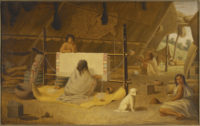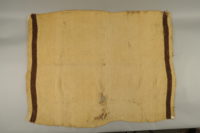 A comprehensive new study published in the Journal of Anthropological Archaeology of archaeological remains of canids has found domestic dogs were ubiquitous among the ancient peoples of the Northwest Coast of what are now the United States and Canada, the product of dedicated domestication and breeding going back at least to the mid-Holocene (7,000 – 5,000 years ago). Wild canids like coyotes, foxes and wolves, on the other hand, are extremely rare. There is nothing like this density of domesticated dog remains associated with any other indigenous peoples elsewhere in North America.
A comprehensive new study published in the Journal of Anthropological Archaeology of archaeological remains of canids has found domestic dogs were ubiquitous among the ancient peoples of the Northwest Coast of what are now the United States and Canada, the product of dedicated domestication and breeding going back at least to the mid-Holocene (7,000 – 5,000 years ago). Wild canids like coyotes, foxes and wolves, on the other hand, are extremely rare. There is nothing like this density of domesticated dog remains associated with any other indigenous peoples elsewhere in North America.
Researchers from the University of Victoria examined 172,310 mammal bones unearthed over 55 years of archaeological exploration at 210 sites. Of those, 1,400 were canid bones recovered from 49 different sites. More than 99% of them came from domesticated dogs. The remains of domesticated dogs came in two distinct types: one small, Spitz-like breed and one medium-sized dingo-like dog. The small one was the Salish wool dog. The larger were “village dogs,” used for hunting and protection.
The study found the greatest density of domesticated dog bones on the east coast of Vancouver island, the mouth of the Fraser River and the Gulf Island, areas where traditional accounts and documented European encounters record the presence of the small dogs and their prized wool. It’s likely that these were centers of carefully controlled breeding — the woollies and the village dogs were kept strictly apart to ensure the healthy survival of the recessive gene that makes the characteristic coat — and that the dogs were traded to other groups.
 Northwest Coast nations like the Coast Salish in what is now Washington state and the Tseshaht people of British Columbia, for millennia bred small dogs with dense, woolly coats specifically for the production of textiles. The dog wool textiles evolved from local objects of use and craft into a major currency for international trade. The cultural and economic importance of them to the Northwest Coast peoples explains why there is such a great number of domesticated canids on the archaeological record there and nowhere else.
Northwest Coast nations like the Coast Salish in what is now Washington state and the Tseshaht people of British Columbia, for millennia bred small dogs with dense, woolly coats specifically for the production of textiles. The dog wool textiles evolved from local objects of use and craft into a major currency for international trade. The cultural and economic importance of them to the Northwest Coast peoples explains why there is such a great number of domesticated canids on the archaeological record there and nowhere else.
In a related study published in Scientific Reports of recently-excavated skeletal remains of woolly dogs found on Keith Island, one of the Broken Group of islands in Barkley Sound on the west coast of Vancouver Island, British Columbia, researchers were able to use stable isotope analysis to discover what the woolly dogs ate. Spoiler: like kings.
“Our research indicates that Tseshaht dogs were eating and possibly being fed significant amounts of marine fish—specifically, anchovy, herring and salmon—amounting to approximately half of the food they consumed throughout their lives,” says Hillis.
“We were able to provide direct and detailed evidence for the consumption of marine resources by dogs and humans of Tseshaht territory,” Hillis adds. “Obviously, the role that humans took was substantial since dogs were not catching these fast-moving fish on their own,” he adds.
Nothing like fish oil to make a dog’s coat healthy and glossy.
All very good boys and girls.
Thanks in general for your marvelous blog. It always leads to new and interesting places. You, Livius, are succeeding in your endeavor. :notworthy: